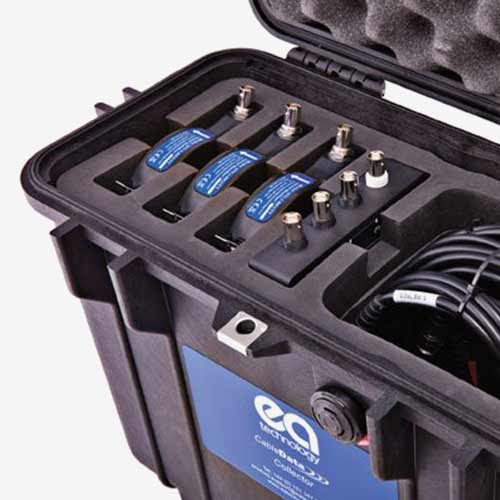Partial Discharge Detection
About Partial Discharge Detection
Partial discharge detection is a non-destructive test used to identify and locate defects in the insulation of high-voltage equipment. Partial discharges are electrical discharges that occur between two conductors within an insulation system. They are caused by localised electrical stresses that exceed the breakdown strength of the insulation. Partial discharges can damage the insulation and lead to premature failure of the equipment.
Popular Products
-
EA Technology UTP2 Kit 3: Professional Pack: A complete solution for detecting partial discharge (PD) in electrical systems. It includes the UltraTEV Plus² instrument, which differentiates true PD from noise, and the UltraDish™ option for overhead measurements. The kit also features a Peltor headset, chargers, micro USB cable, SD card, carrying case, screen protector, styluses, ultrasonic contact probe, flexible sensor, and HFCT sensor.
-
Megger UHF Partial Discharge Detector: Handheld, non-invasive tool for surveying medium and high voltage substations. It helps identify faults before failures occur, featuring dual measurement channels for sensor comparison and a large colour touch screen for easy operation. Its high bandwidth allows accurate online PD measurements on HV components, including cable terminations and surge arrestors.
-
EA Technology UTP2-USB MicroUSB Cable: A key accessory for the UltraTEV Plus2 Partial Discharge Detector. It enables smooth data transfer to PCs or networks, ensuring easy upload of critical measurements.
-
EA Technology UTP2-CC UltraTEV Detector2 In-Car Charger: Keeps your UltraTEV Detector2 and UltraTEV Plus2 powered on the go. It plugs into your vehicle’s cigarette lighter, allowing for charging during travel between job sites. Its durable design ensures reliable performance, making it essential for professionals needing equipment readiness in the field.
FAQs
-
What Causes Partial Discharge?
Partial Discharge (PD) occurs due to localized electrical discharges in high-voltage insulation, often caused by defects like voids or gas-filled cavities that reduce dielectric strength. Contamination from dirt or moisture can create conductive paths while ageing and degradation lower insulation resilience. Improper installation or mechanical damage may also introduce defects. Understanding these causes is vital for effective monitoring and maintenance to prevent insulation failure and ensure system reliability. -
What are the Techniques for Partial Discharge Testing?
Partial Discharge (PD) Testing uses various techniques to detect and analyze PD in high-voltage equipment. Electrical detection captures high-frequency current pulses, acoustic detection employs piezoelectric transducers for ultrasonic waves, and electromagnetic detection picks up emissions with antennas. Optical detection captures light emissions with photodetectors, while chemical detection analyzes by-products like ozone. Each technique has unique advantages and is selected based on the application and equipment type. -
What is a Partial Discharge Detector?
It identifies and measures partial discharges in high-voltage equipment, preventing insulation failure. It detects signals emitted by PDs due to insulation defects, enabling early intervention to maintain system safety and reliability. -
What happens with Partial Discharge is detected?
Detecting Partial Discharge (PD) signals indicates insulation issues in high-voltage equipment. Severity and location are analyzed, and continuous monitoring tracks progression. Maintenance teams plan repairs, take preventive measures, and document findings to improve asset management. Early detection prevents failures and extends equipment lifespan. -
How can I determine if there is partial discharge activity in a high-voltage asset?
Partial discharge (PD) in high-voltage assets is detected through conventional testing (IEC 60270) and non-conventional methods like electromagnetic, optical, chemical, and acoustic detection. Online monitoring provides continuous data, while offline tests offer detailed diagnostics. -
What are the common types of Partial Discharge?
Void discharge, surface discharge, and corona discharge are common types. Void discharge occurs within gas-filled cavities in solid insulation, surface discharge happens along contaminated or moist surfaces, and corona discharge occurs around sharp edges in high-voltage equipment. Early detection is crucial to prevent insulation damage and ensure system reliability. -
Why is Partial Discharge testing important?
Testing detects early insulation issues that could lead to equipment failures, enabling timely repairs and reducing downtime. PD testing also supports compliance with industry standards, enhances equipment performance, and contributes to proactive maintenance strategies, improving safety for both equipment and personnel. -
What are the methods for detecting Partial Discharge?
Employs methods based on different phenomena: electrical detection captures high-frequency pulses, acoustic detection uses piezoelectric transducers for ultrasonic waves, electromagnetic detection picks up emissions with antennas, optical detection uses photodetectors for light, and chemical detection analyzes by-products like ozone. Each method has unique advantages tailored to specific applications and equipment. -
Is there a standard for acceptable PD levels in cables?
Yes, standards for acceptable Partial Discharge (PD) levels in cables exist, mainly outlined in IEC 60270. This standard defines measurement methods and acceptable PD levels for high-voltage equipment. Compliance is crucial for maintaining insulation quality and preventing failures, as excessive PD can indicate defects that may lead to catastrophic issues. -
Can Partial Discharge be detected online or offline?
Yes, Partial Discharge (PD) can be detected online and offline. Online detection monitors PD in real time during operation, enabling immediate responses for critical assets. Offline detection occurs during scheduled maintenance when equipment is de-energized, allowing for detailed diagnostics without interference. Both methods are essential for comprehensive PD monitoring, ensuring early identification and mitigation of insulation defects to maintain system reliability and safety.


 Partial Discharge Detectors
Partial Discharge Detectors
 Partial Discharge Detector Accessories
Partial Discharge Detector Accessories
